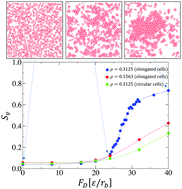Collective motion of cells modeled as ring polymers†
Abstract
In this article, we use a coarse-grained model of disjoint semi-flexible ring polymers to investigate computationally the spatiotemporal collective behavior of cell colonies. A ring polymer in this model is self-propelled by a motility force along the cell's polarity, which depends on its historical kinetics. Despite the repulsive interaction between the cells, a collective behavior sets in as a result of cells pushing against each other. This cooperative motion emerges as the amplitude of the motility force is increased and/or their areal density is increased. The degree of collectivity, characterized by the average cluster size, the velocity field order parameter, and the polarity field nematic order parameter, is found to increase with increasing the amplitude of the motility force and area coverage of the cells. Furthermore, the degree of alignment exhibited by the cell velocity field within a cluster is found to be stronger than that exhibited by the cell polarity. Comparison between the collective behavior of elongated cells and that of circular cells, at the same area coverage and motility force, shows that elongated cells exhibit a stronger collective behavior than circular cells, in agreement with earlier studies of self-propelled anisotropic particles. An investigation of two-cell collisions shows that while two clustered cells move in tandem, their polarities are misaligned. As such the cells push against each other while moving coherently.



 Please wait while we load your content...
Please wait while we load your content...